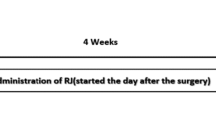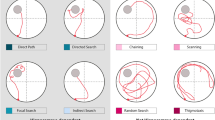Abstract
Objective
Alzheimer’s disease (AD) is one of the most important neurodegenerative disorders. It is characterized by dementia including deficits in learning and memory. The present study aimed to evaluate the effects of aqueous extract of lavender (Lavandula angustifolia) on spatial performance of AD rats.
Methods
Male Wistar rats were first divided into control and AD groups. Rat model of AD was established by intracerebroventricular injection of 10 μg Aβ1–42 20 d prior to administration of the lavender extract. Rats in both groups were then introduced to 2 stages of task learning (with an interval of 20 d) in Morris water maze, each followed by one probe test. After the first stage of spatial learning, control and AD animals received different doses (50, 100 and 200 mg/kg) of the lavender extract.
Results
In the first stage of experiment, the latency to locate the hidden platform in AD group was significantly higher than that in control group. However, in the second stage of experiment, control and AD rats that received distilled water (vehicle) showed similar performance, indicating that the maze navigation itself could improve the spatial learning of AD animals. Besides, in the second stage of experiment, control and AD rats that received lavender extract administration at different doses (50, 100, and 200 mg/kg) spent less time locating the platform (except for the AD rats with 50 mg/kg extract treatment), as compared with their counterparts with vehicle treatment, respectively. In addition, lavender extract significantly improved the performance of control and AD rats in the probe test, only at the dose of 200 mg/kg, as compared with their counterparts with vehicle treatment.
Conclusion
The lavender extract can effectively reverse spatial learning deficits in AD rats.
摘要
目的
阿尔茨海默病(Alzheimer’s disease, AD)是主要的神经退行性疾病之一, 其特征主要表现为痴呆, 包括学习与记忆的衰退。 本研究旨在探索薰衣草(唇形科, 薰衣草属)水提取物对AD大鼠空间学习和记忆的影响。
方法
Wistar大鼠分为对照组和AD 组, 通过给大鼠脑室注射10 μg Aβ1–42 建立AD模型。 20天后, 两组大鼠进行为期 5天的水迷宫空间记忆采集实验(每天4次), 紧接着进行一次空间探索实验。 实验结束后, 分别给予AD组和对照组大鼠不同剂量的薰衣草水提取物(50、 100、 200 mg/kg) 或 0.4 mL/kg 蒸馏水, 每天一次共20天。 随后, 重复上述水迷宫实验。
结果
在水迷宫实验的第一阶段, AD组大鼠找到平台的潜伏期显著高于对照组大鼠, 而在第二阶段, 接受蒸馏水注射的对照和AD大鼠找到平台的潜伏期没有差异, 说明水迷宫运动本身能提高AD大鼠的空间学习能力。 在第二阶段空间记忆采集实验中, 与接受蒸馏水注射的同类大鼠相比, 接受薰衣草水提取物注射的对照和AD大鼠找到平台的潜伏期显著降低。 此外, 200 mg/kg 薰衣草水提取物能显著提高对照和AD大鼠的空间探索能力。
结论
薰衣草水提取物能有效逆转AD 大鼠空间学习功能的损伤。
Similar content being viewed by others
References
Fodale V, Quattrone D, Trecroci C, Caminiti V, Santamaria L B. Alzheimer’s disease and anaesthesia: implications for the central cholinergic system. Br J Anaesth 2006, 97(4): 445–452.
Morrissette DA, Parachikova A, Green KN, LaFerla FM. Relevance of transgenic mouse models to human Alzheimer disease. J Biol Chem 2009, 284(10): 6033–6037.
Gatz M, Reynolds CA, Fratiglioni L, Johansson B, Mortimer JA, Berg S, et al. Role of genes and environments for explaining Alzheimer disease. Arch Gen Psychiatry 2006, 63(2): 168–174.
Selkoe DJ. Alzheimer’s disease: genes, proteins, and therapy. Physiol Rev 2001, 81(2): 741–766.
Iqbal K, Alonso Adel C, Chen S, Chohan MO, El-Akkad E, Gong CX, et al. Tau pathology in Alzheimer disease and other tauopathies. Biochim Biophys Acta 2005, 1739(2–3): 198–210.
Kosik KS, Joachim CL, Selkoe DJ. Microtubule-associated protein tau (tau) is a major antigenic component of paired helical filaments in Alzheimer disease. Proc Natl Acad Sci U S A 1986, 83(11): 4044–4048.
Howlett DR, Simmons DL, Dingwall C, Christie G. In search of an enzyme: the beta-secretase of Alzheimer’s disease is an aspartic proteinase. Trends Neurosci 2000, 23(11): 565–570.
Tuppo EE, Arias HR. The role of inflammation in Alzheimer’s disease. Int J Biochem Cell Biol 2005, 37(2): 289–305.
Dheen ST, Kaur C, Ling EA. Microglial activation and its implications in the brain diseases. Curr Med Chem 2007, 14(11): 1189–1197.
Strohmeyer R, Rogers J. Molecular and cellular mediators of Alzheimer’s disease inflammation. J Alzheimers Dis 2001, 3(1): 131–157.
Lahiri DK, Farlow MR, Greig NH, Sambamurti K. Current drug targets for Alzheimer’s disease treatment. Drug Dev Res 2002, 56(3): 267–281.
Bourin M, Ripoll N, Dailly E. Nicotinic receptors and Alzheimer’s disease. Curr Med Res Opin 2003, 19(3): 169–177.
Abeliovich A, Paylor R, Chen C, Kim JJ, Wehner JM, Tonegawa S. PKC gamma mutant mice exhibit mild deficits in spatial and contextual learning. Cell 1993, 75(7): 1263–1271.
Celone KA, Calhoun VD, Dickerson BC, Atri A, Chua EF, Miller SL, et al. Alterations in memory networks in mild cognitive impairment and Alzheimer’s disease: An independent component analysis. J Neurosci 2006, 26(40): 10222–10231.
Yamin G. NMDA receptor-dependent signaling pathways that underlie amyloid beta-protein disruption of LTP in the hippocampus. J Neurosci Res 2009, 87(8): 1729–1736.
Omidbaigi R. Production and processing of medicinal plants. Astane Ghods Publications 2000, 3: 106–122.
Akhondzadeh S, Kashani L, Fotouhi A, Jarvandi S, Mobaseri M, Moin M, et al. Comparison of Lavandula angustifolia Mill. tincture and imipramine in the treatment of mild to moderate depression: a double-blind, randomized trial. Prog Neuropsychopharmacol Biol Psychiatry 2003, 27(1): 123–127.
Kim HM, Cho SH. Lavender oil inhibits immediate-type allergic reaction in mice and rats. J Pharm Pharmacol 1999, 51(2): 221–226.
Adsersen A, Gauguin B, Gudiksen L, Jager AK. Screening of plants used in Danish folk medicine to treat memory dysfunction for acetylcholinesterase inhibitory activity. J Ethnopharmacol 2006, 104(3): 418–422.
Hajhashemi V, Ghannadi A, Sharif B. Anti-inflammatory and analgesic properties of the leaf extracts and essential oil of Lavandula angustifolia Mill. J Ethnopharmacol 2003, 89(1): 67–71.
Lin PW, Chan WC, Ng BF, Lam LC. Efficacy of aromatherapy (Lavandula angustifolia) as an intervention for agitated behaviours in Chinese older persons with dementia: a cross-over randomized trial. Int J Geriatr Psychiatry 2007, 22(5): 405–410.
Wilcock DM, Gordon MN, Morgan D. Quantification of cerebral amyloid angiopathy and parenchymal amyloid plaques with Congo red histochemical stain. Nat Protocols 2006, 1(3): 1591–1595.
Lustig C, Snyder AZ, Bhakta M, O’Brien KC, McAvoy M, Raichle ME, et al. Functional deactivations: change with age and dementia of the Alzheimer type. Proc Natl Acad Sci U S A 2003, 100(24): 14504–14509.
Friedland RP, Fritsch T, Smyth KA, Koss E, Lerner AJ, Chen CH, et al. Patients with Alzheimer’s disease have reduced activities in midlife compared with healthy control-group members. Proc Natl Acad Sci U S A 2001, 98(6): 3440–3445.
Smyth KA, Fritsch T, Cook TB, McClendon MJ, Santillan CE, Friedland RP. Worker functions and traits associated with occupations and the development of AD. Neurology 2004, 63(3): 498–503.
Letenneur L, Gilleron V, Commenges D, Helmer C, Orgogozo JM, Dartigues JF. Are sex and educational level independent predictors of dementia and Alzheimer’s disease? Incidence data from the PAQUID project. J Neurol Neurosurg Psychiatry 1999, 66(2): 177–183.
Cracchiolo JR, Mori T, Nazian SJ, Tan J, Potter H, Arendash GW. Enhanced cognitive activity—over and above social or physical activity—is required to protect Alzheimer’s mice against cognitive impairment, reduce Abeta deposition, and increase synaptic immunoreactivity. Neurobiol Learn Mem 2007, 88(3): 277–294.
Inestrosa NC, Alvarez A, P’erez CA, Moreno RD, Vicente M, Linker C, et al. Acetylcholinesterase accelerates assembly of amyloid-[beta]-peptides into Alzheimer’s fibrils: Possible role of the peripheral site of the enzyme. Neuron 1996, 16(4): 881–891.
Perry N, Court G, Bidet N, Court J, Perry E. European herbs with cholinergic activities: potential in dementia therapy. Int J Geriatr Psychiatry 1996, 11(12): 1063–1069.
Koh JY, Yang LL, Cotman CW. Beta-amyloid protein increases the vulnerability of cultured cortical neurons to excitotoxic damage. Brain Res 1990, 533(2): 315–320.
Author information
Authors and Affiliations
Corresponding author
Rights and permissions
About this article
Cite this article
Kashani, M.S., Tavirani, M.R., Talaei, S.A. et al. Aqueous extract of lavender (Lavandula angustifolia) improves the spatial performance of a rat model of Alzheimer’s disease. Neurosci. Bull. 27, 99–106 (2011). https://doi.org/10.1007/s12264-011-1149-7
Received:
Accepted:
Published:
Issue Date:
DOI: https://doi.org/10.1007/s12264-011-1149-7




